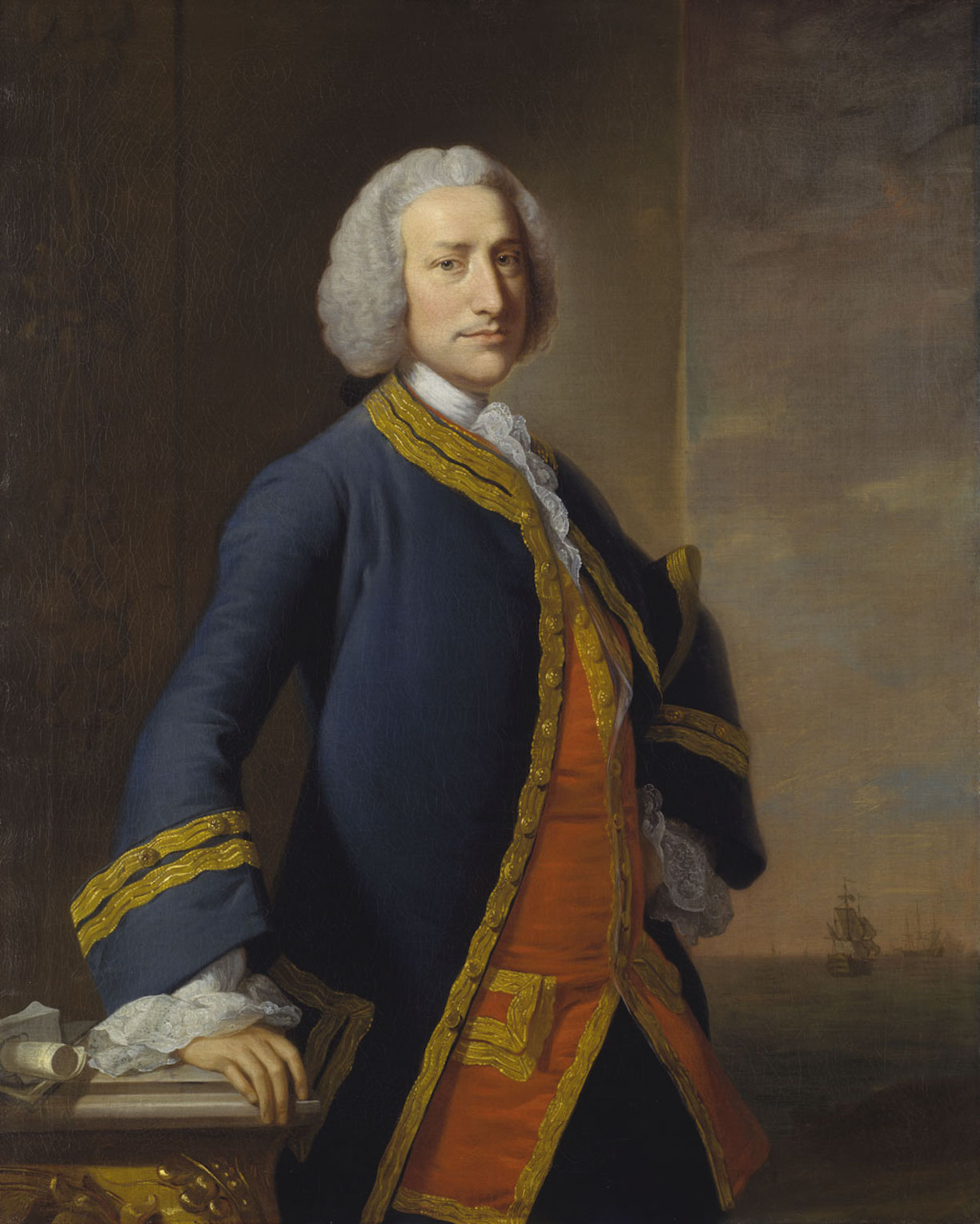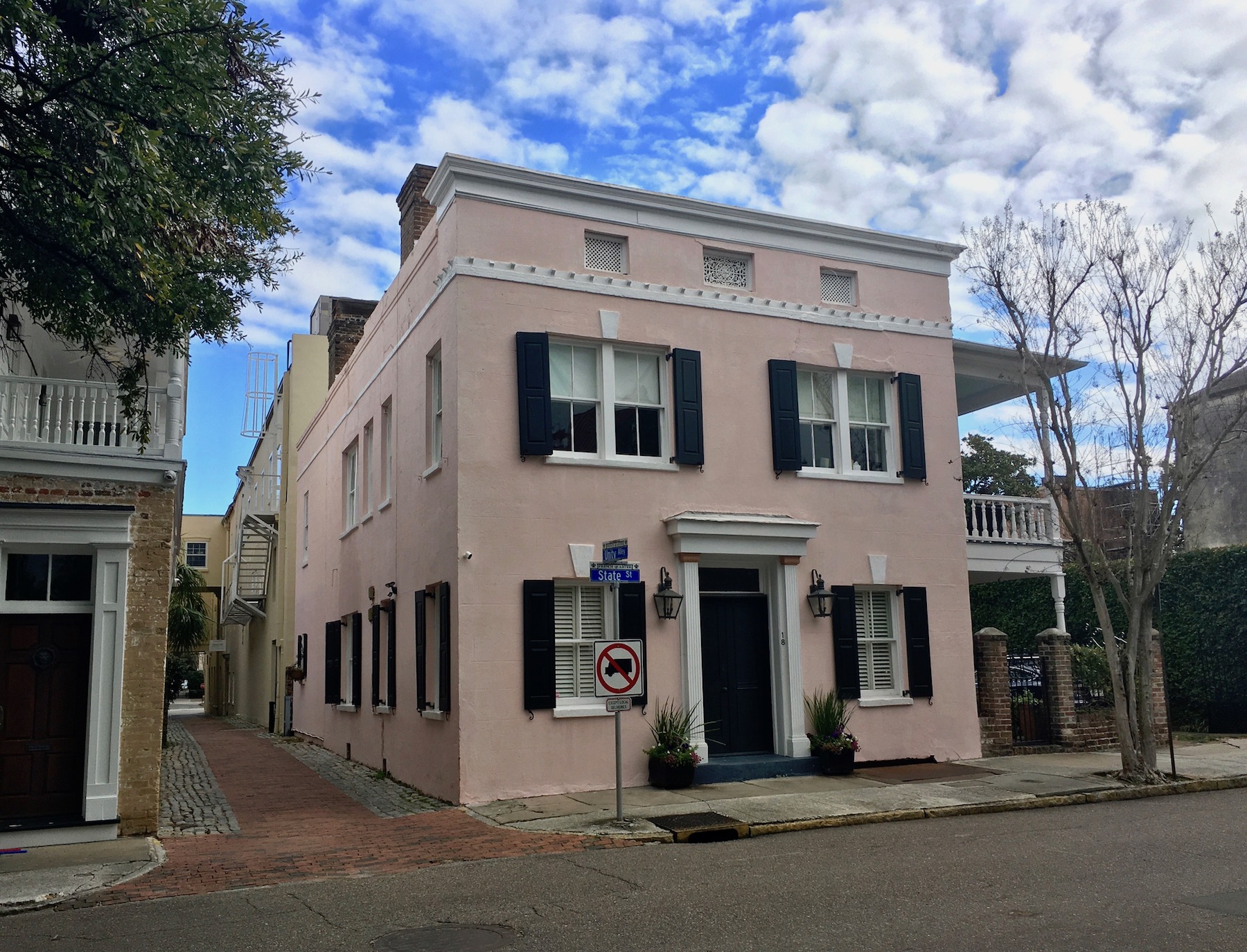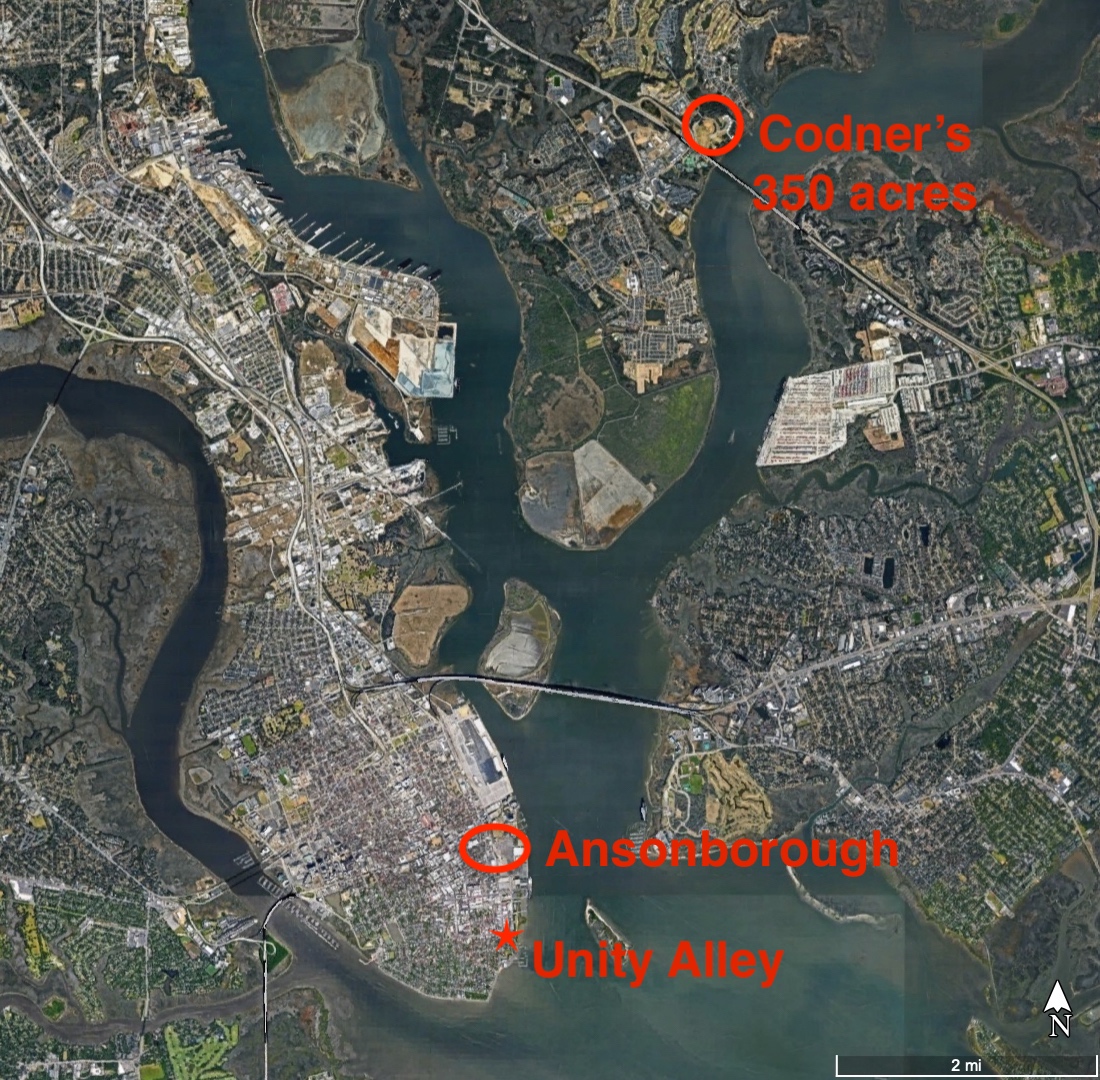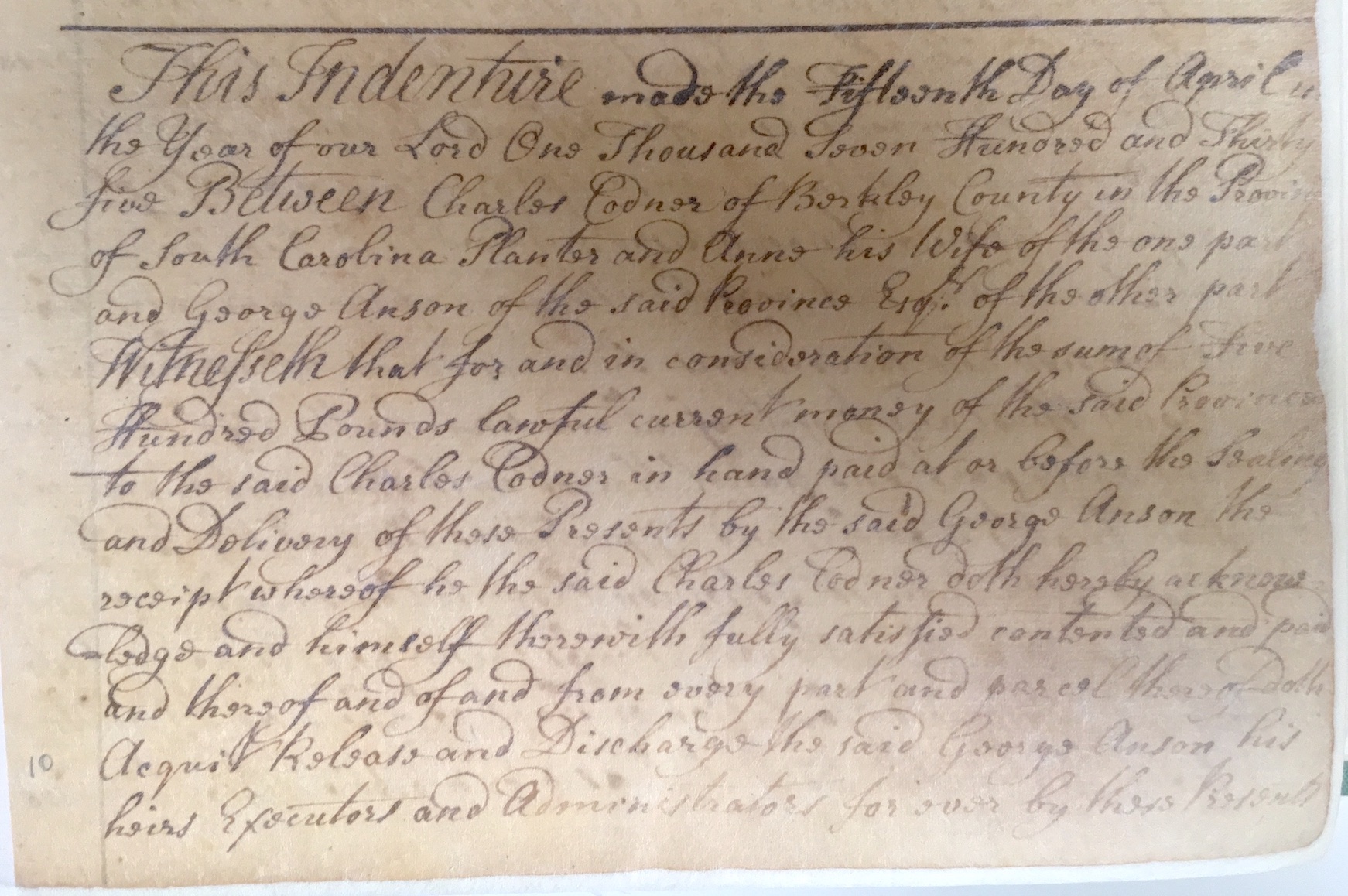
An old local legend says that George Anson acquired the land now called Ansonborough in a card game with Thomas Gadsden. While the documents related to their 1727 transaction contain no hint of a gambling debt, the circumstances surrounding another Anson property in South Carolina are far more suspicious. The details relating to a conveyance and a mortgage from Mr. and Mrs. Charles Codner of Daniel Island suggest that the legend of Captain Anson’s gambling success might have been applied to the wrong property. Let’s explore the evidence, and you can draw your own conclusions.
George Anson (1697–1762) was a young captain in the British Navy when he resided in Charleston for a total of nine years between July 1724 and June 1735, during which time he commanded three different warships in succession—His Majesty’s ships Scarborough, Garland, and Squirrel. Besides protecting the Carolina coastline from pirates and privateers, Captain Anson also purchased several pieces of property in the Lowcountry, including a small lot in urban Charleston, a suburban plantation just outside the town, and a large tract of wilderness near Hilton Head Island. Commodore Anson became a national hero in Britain in 1744 after completing a four-year voyage around the globe and returning to London with ships filled with tons of Spanish treasure. Following another promotion, Admiral Anson defeated a French fleet in the Atlantic in 1747 and earned the title of Lord Anson, Baron of Soberton. Meanwhile in South Carolina, Anson’s local attorney subdivided his suburban plantation, called the Bowling Green, into a new residential neighborhood called Ansonborough, the many parcels of which were sold between 1745 and 1761.

In an effort to be thorough in my research, I’ve also spent some time exploring the history of the gambling legend itself to see if its roots might reveal some useful information. To the best of my knowledge, this local tradition first appeared in print in Joseph Johnson’s 1851 publication, Traditions and Reminiscences Chiefly of the American Revolution in the South. Let’s consider Johnson’s brief text in its entirety: “When Lord Anson arrived in Charleston about the year 1733, he was hospitably received by the inhabitants, and entertained by the collector, Thomas Gadsden. His lordship was so fond of gambling, that he has been censured for even winning money from his humble midshipmen. It was said that Mr. Gadsden played with his lordship, lost a large sum of money, and paid the debt of honor by giving him titles for all these lands, which to this day bear the designation of Ansonborough.”[4]
I’ve yet to find any evidence that the Lords of the Admiralty scolded Captain Anson for gambling with his subordinates, but let’s ignore that rabbit hole for the moment and focus our attention on local matters. Note that Johnson did not specify that the men in question were playing cards, but were simply “gambling” in a more general sense. The author also misremembered the dates of Captain Anson’s tenure in Charleston; he first arrived in 1724, departed in 1730, and then returned in 1732. If you read the rest of the text surrounding the aforementioned quotation, you’ll also see that Johnson possessed a limited understanding of the original geographic boundaries of that large property. In short, Joseph Johnson, writing in 1851, misremembered the details of both George Anson’s career and the early history of Ansonborough. To what extent, therefore, can we consider him a reliable source of information for the alleged gambling debt?

Besides the 1727 purchase of the acreage that became Ansonborough, Captain Anson purchased two additional properties in South Carolina and held mortgages on a further two tracts. Contemporary documentation survives for all five of these real estate transactions, although some of the original materials are now missing. Two of these properties appear to have been legitimate, long-term, speculative investments. The circumstances surrounding three of the five properties are so obscure, however, that, in my opinion, merit an eyebrow raised in suspicion. How and why George Anson briefly held a mortgage on a rural tavern called the Quarter House in 1730, for example, is a mystery to me, but we’ll investigate that story in a future program. For the moment, I’d like to focus our investigative spotlight on a pair of last-minute transactions between Captain Anson and a young married couple who owned property on both the Charleston peninsula and what is now called Daniel Island.
A few weeks prior to his departure from South Carolina in early June 1735, George Anson participated in two curious property transactions with an affluent young planter named Charles Codner (1710–1747) and his wife, the former Miss Anne Barnet (born ca. 1715). The legal records of these transactions—a sale and a mortgage—are not unusual in any technical sense, but the surviving documents shed no light on the nature of the relationship between the parties or the motivations that brought them together. The circumstances in which thirty-eight-year-old Captain Anson and the young colonial couple might have met and socialized are unknown, and I have uncovered no evidence of a prior professional, commercial, or social connection between them. By exploring the broader context of their respective lives in that era, however, we might discern evidence of a plausible scenario to explain their valuable interactions.

On the 10th and 11th of April, while His Majesty’s ship the Squirrel was anchored in Charleston Harbor abreast of East Bay Street, Charles and Anne Codner executed a lease and release to Captain Anson conveying ownership of a small lot situated in the heart of the town for the sum of £500 South Carolina currency (approximately £71.8.6 sterling). The property in question, located at the southwest end of Unity Alley (now No. 18 State Street), measured just twenty-five feet on the east side of Union (now State) Street and 125 feet along the south side of the alley.[7] The Codners still owned the adjacent property to the south, while the attorneys of George Anson’s former business partner, John Raper, a young Yorkshire vintner, owned a tavern immediately to the east, facing East Bay Street and the town’s wharves. The documents recording this sale do not describe any sort of structure on the lot at the time, but this fact is not unusual for property conveyances of that era. Considering its proximity to the busy waterfront and the profusion of commerce surrounding the centrally-located lot, however, the absence of a functioning commercial and residential structure would have been rather unusual.
A few days after purchasing the urban lot, Captain Anson and the crew of the Squirrel slipped their anchor cables and sailed a short distance northward into the Wando River. As they had done many times before, they turned the ship eastward into Hobcaw Creek, opposite Daniel Island, to clean the ship’s bottom before sailing back to England. On the 14th and 15th of April, while the crew emptied the hull and prepared to careen the ship, Anson departed and met with Mr. and Mrs. Codner—perhaps at their home on Daniel Island—to execute another property transaction. In exchange for the additional sum of £500 currency, the Codners mortgaged to Anson a tract of 350 acres on “Itowan” (Daniel) Island, bounded by the Wando River to the south, Beresford Creek to the north, and to the east by what is now called Ralston Creek. Rather than vacating their rights to the property entirely, however, the young couple stipulated that the acreage in question was offered as collateral to ensure a payment of £500 currency, plus 10% interest, to Captain Anson within two years. If Charles Codner failed to repay the debt by the appointed date, then he and his wife agreed to convey full legal ownership of the tract to Anson.[8]
In both of the aforementioned transactions, the respective documents include the customary legal language of the period stating that the purchase money was “in hand paid at or before” the conclusion of the proceedings. At the end of each transaction, Charles Codner appended a note reiterating that he had personally received the aforementioned £500 from George Anson. Such language would seem to confirm beyond doubt that the captain had indeed paid to young Mr. Codner the sum of £1,000 currency (approximately £142.17.0 sterling, nearly one year’s salary) during the course of one week, but extenuating circumstances cast a modicum of doubt over the entire affair. Days away from his departure from South Carolina, Anson had little use for the properties in question. Charles Codner had previously mortgaged the same 350 acres on Daniel Island to another party in 1731 and satisfied the note in less than two years.[9] Codner was clearly indebted to the captain in some respect, but the nature of his obligation is unknown. What reason might have compelled George Anson to hand the equivalent of a year’s worth of his naval salary to a feckless young colonial planter, to whom he shared no known family or professional connection?

Even if we accept the possibility that Charles Codner owed a gambling debt to George Anson in the spring of 1735, the surviving documentation provides no clues to the nature of their game or wager. As I mentioned earlier, local legend asserts that the naval captain was fond of playing at cards, but I’d like to offer another theory. On the first day of February, 1735, during Anson’s final, idle months in South Carolina, he hosted the earliest-known horse race in the colony at his suburban Bowling Green plantation. Advertisements for the one-mile heat appeared in the local newspaper, the South Carolina Gazette, during the month of January, but the post-race newspapers carried no further information about the event nor the identity of the rider who took home the winning prize—“a handsome sadle [sic] and bridle” valued at £20 currency (nearly £3 sterling).[10] Despite the paucity of surviving details about this equestrian competition, the timing of the event might suggest a connection to the curious transactions between George Anson and Charles Codner. At the conclusion of the horse race on February 1st, or perhaps some earlier, unadvertised race, did Codner owe £1,000 currency to Captain Anson? Was Codner unable to amass the necessary cash before the captain’s imminent departure from the colony? Did the young planter offer the title to his urban lot on Unity Alley and a mortgage on a Daniel Island tract to satisfy his debt to Anson? In all honesty, we might never learn the truth about the nature of these transactions. I think you’ll agree, however, that the circumstantial evidence surrounding this case is sufficiently unusual to arouse suspicion.

Nearly three centuries after Thomas Gadsden sold his suburban plantation to George Anson in 1727, and many generations since the initial subdivision of Ansonborough in 1745, the legend of a card game between the two mariners persists. I believe that this story contains a kernel of truth that has been misremembered, however, and might be applied to several other contemporary transactions. Whether George Anson truly paid £1,000 currency to Charles and Anne Codner in 1735 as a legitimate investment, or whether the Codners sacrificed their property to satisfy a gambling debt, one fact remains clear. Captain Anson made a handsome profit from his last speculative ventures in the colony of South Carolina.
[1] See Charles II, 1664: “An Act against deceitfull disorderly and excessive Gameing,” in Statutes of the Realm: Volume 5, 1628–80, ed. John Raithby (s.l: Great Britain Record Commission, 1819), 523. British History Online, accessed 14 January 2021, http://www.british-history.ac.uk/statutes-realm/vol5/p523.
[2] Just one month after selling this small suburban plantation to Captain Anson, for example, Gadsden paid £200 sterling for a well-situated rural tract of 300 acres. That property, located on the fertile upper reaches of the Ashley River, was more likely to be productive and profitable than the smaller and relatively constrained suburban tract he sold to Anson; see Alexander Skene to Thomas Gadsden, release for £1400 currency (£200 sterling) of 300 acres, part of Ashley Barony, dated 29 April 1727, recorded in Charleston County Register of Deeds (hereafter RoD), book I: 179.
[3] Thomas Gadsden to George Anson, lease and release for £300 sterling, 23–24 March 1726/7, RoD book F: 89–99.
[4] Joseph Johnson, Traditions and Reminiscences Chiefly of the American Revolution in the South (Charleston, S.C.: Walker and James, 1851), 38. This information was repeated by many later writers, including E. Stanley Godbold and Robert H. Woody, Christopher Gadsden and the American Revolution (Knoxville: University of Tennessee Press, 1982), 6.
[5] Robert F. Clute, ed., The Annals and Parish Register of St. Thomas and St. Denis Parish, in South Carolina, from 1680 to 1884 (Charleston, S.C.: Walker, Evans & Cogswell, 1884), 53; Mabel L. Webber, “Grimball of Edisto Island,” South Carolina Historical and Genealogical Magazine 23 (January 1922): 4; A. S. Salley Jr., ed., Register of St. Philip’s Parish, Charles town, South Carolina, 1720–1758 (Charleston, S.C.: Walker, Evans & Cogswell, 1904), 161; a profile of Richard Codner, father of Charles, appears in Walter B. Edgar and N. Louise Bailey, eds., Biographical Directory of the South Carolina House of Representatives, volume 2 (Columbia: University of South Carolina Press, 1977), 159.
[6] See “An Act for establishing five ferries; one over Winyaw river, two over Santee River, one over Sampit Creek, and one over Cooper River,” ratified on 20 August 1731, in David J. McCord, The Statutes at Large of South Carolina, volume 9 (Columbia, S.C.: A. S. Johnston, 1841), 69–73.
[7] Charles Codner and Anne, his wife, to George Anson, lease and release for £500 currency, 10–11 April 1735, RoD book O: 11–17; Anne Codner renounced her dower rights to this lot on 7 May 1735; see South Carolina Department of Archives and History (hereafter SCDAH), Renunciation of Dower Books (Court of Common Pleas), volume beginning in 1733, page 80. The process of widening Union Street to create the present State Street in 1812–13 required to removal of many buildings from the west side of the street, but that work did not diminish the size of the lot Anson purchased in 1735, which is now identified as No. 18 State Street.
[8] Charles Codner, and Anne, his wife, to George Anson, mortgage by lease and release, 14–15 April 1735, RoD book O: 18–25.
[9] See Charles Codner to John Daniel, mortgage of 350 acres, 14 March 1731, RoD book K: 29.
[10] South Carolina Gazette, 11–18 January 1734/5.
[11] Charles Codner to John Beresford, lease and release, 17–18 January 1736/7, RoD book R: 164–69.
[12] George Anson, commander of HMS Centurion, by his attorney Benjamin Whitaker, to John Triboudet, vintner, lease and release, 25–26 June 1741, RoD book W: 7–11. The inventory of Charles Codner’s personal effects, dated 19 October 1747, appears in SCDAH, inventories of estates, book MM (1746–1748), 200–1.
NEXT: Street Auctions and Slave Marts in Antebellum Charleston
PREVIOUSLY: The Other New Years: Regnal, Civil, and Personal
See more from Charleston Time Machine
